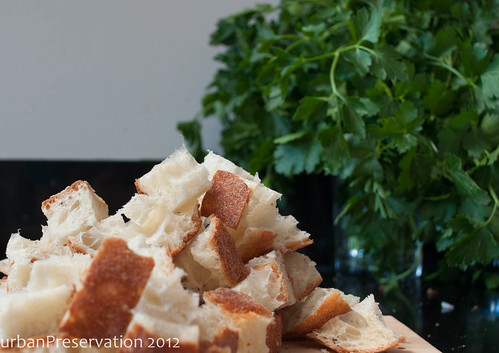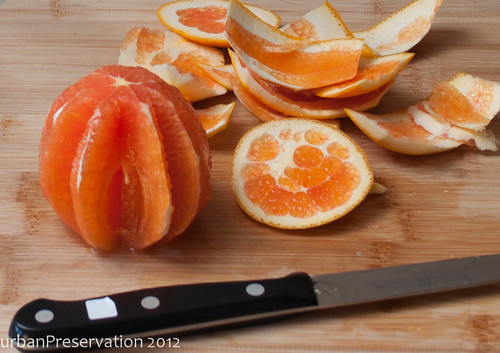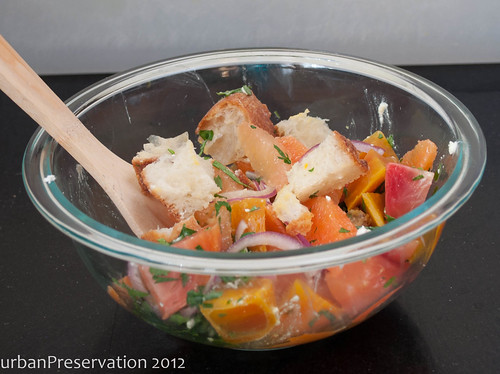
San Francisco is a town that takes its bread seriously and there are lots of good inexpensive bread to be had pretty much everywhere you go. As a result, we often have half a loaf of something laying around that should have been eaten on the day we bought it, which was generally at least three days ago. I’ll admit I’m not above eating slightly stale bread but there comes a point when the loaf cracks when you cut it and at that point, even I can’t bring myself to eat a slice. Yes, this is perfect for making breadcrumbs, but there are only so many breadcrumbs you can have before you have to look for other ways to use stale bread.

Panzanella combines leftover stale bread with salad ingredients which softens the bread and makes it partly chewy and partly crunchy. But in winter, I won’t be caught dead putting sad mealy tomatoes in my salad so I had to come up with a variety of winter ingredients to substitute for the traditional flavors and textures. Traditionally, panzanella has tomatoes, cucumber and/or bell pepper, red onion, and basil along with vinaigrette and maybe some parmesan. So that’s something sweet and juicy, something crunchy and juicy, something sharp, an herb to tie it together, and an optional cheese.

Beets are everywhere in the winter and I love their juicy yet firm texture. Red beets would be too sweet in this situation but the golden and candystriped beets I used aren’t as sweet and as a bonus, they aren’t as likely to dye all the other ingredients bright pink. For the juicy and sweet element, citrus fruits were the obvious choice since the varieties are endless, especially in winter. I used a grapefruit, two cara cara oranges (which are pink inside!) and a mandarin for this recipe, supremed of course, but any kind of citrus will do. The herbal element became parsley, the red onions stayed, and the cheese was played by a few ounces of feta.

Mix the salad together about 15 minutes before you plan to eat it, to allow the bread time to soften, but I find this is one of those things that really does not hold up in the fridge overnight. If I have more that I know will be eaten in one meal, I might save the extra salad ingredients separate from the bread cubes so the next day’s batch won’t have gone from chewy to soggy. The best part about this salad is since it’s more substantial (and less virtuous feeling) that the typical lettuce variety, it can just as easily be served as a meal on its own; nothing else needed.
Winter Panzanella
4 cups of stale bread, cubed
4-5 medium sized beets, roasted, halved, and cut into slices
1 small red onion, thinly sliced
4 citrus fruits, supremed - orange, grapefruit, lemon, etc
1/2 cup finely chopped parsley
3-4 ounces crumbled feta (about 1/3 cup)
Juice of 1 lemon
1/4 cup olive oil
1 tsp mustard
2 tsp plus 1/2 tsp kosher salt
Arrange the bread cubes on a tray so that no pieces are touching and leave overnight to dry out.*
combine sliced beets, red onion, citrus segments, parsley, 2 tsp salt, and feta in a large bowl.
In a small container with a lid combine lemon juice, olive oil, mustard, and 1/2 tsp salt. Shake well for 1 minute until well combined.
15 minutes before serving, add bread cubes to the beet and citrus mixture. Pour over vinaigrette and stir to combine. Let sit for 15-30 minutes for bread to absorb juices. Serve cold or room temperature.
*If your bread is stale all the way through the loaf, you can skip this step.
No comments:
Post a Comment